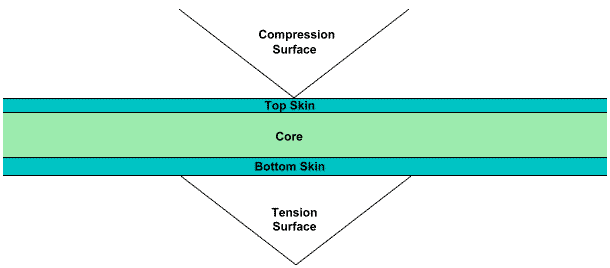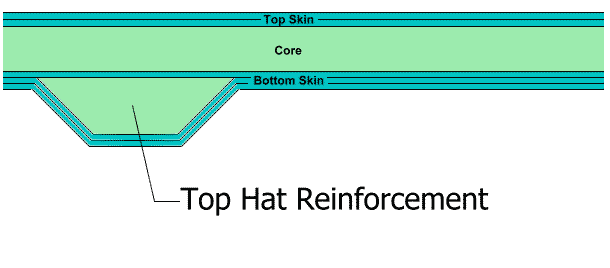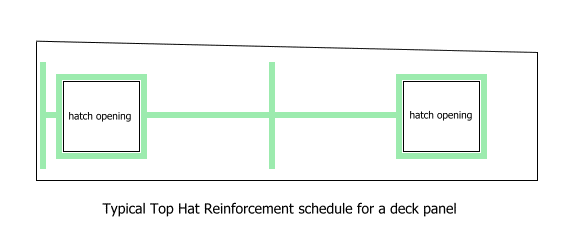
Basic Composite Structure and Benefits of Core Materials
The use of core materials can be very advantageous. When foam core material is used to double the thickness of a structure, the relative stiffness increases 7 times. The strength increases 3.5 times while the weight only increases 1.03 times. When core material quadruples the thickness, the relative stiffness increases an incredible 37 times, the strength increases 9.2 times, but the weight only increases a mere 1.06 times.

The diagram above illustrates a basic composite structure, such as would be used for a deck. The nature of a composite structure is best stated as the combining of different material layers to achieve a structure that is stronger and stiffer than the sum of the individual parts alone. For example a single layer fiberglass skin is hard, but very flexible. A 3/4" panel of PVC foam core, (such as Divinycell), is light, brittle, and somewhat flexible. When the core is bonded on both sides with the fiberglass skins, a compression/tension ratio is established. The thicker the core the greater the ratio and the stronger the composite becomes. To further increase the strength of the composite, the skin thickness can be varied. If two skins of the same thickness are employed, the composite has the same flex characteristics from either side. If one skin is thicker, the composite will exhibit less compression flex on the side opposite the thicker skin. This is used to advantage in decking since the loading forces are always on the top of the deck. The top skin can be relatively thin, using a much heavier lower skin. This creates a greater tension on the bottom of the composite thereby yielding a stronger deck. The top skin only needs to be heavy enough to protect the core from the normal loading traffic. In the case of a cockpit deck on a sport fishing boat, the top skin could be as thin as 1/8", while the bottom skin should be at least 1.5 times thicker, but does not need to exceed 2.0 times the top skin thickness. Choice of fiberglass materials can also add strength. In the case of the deck, the top skin can be a combination of standard weave 7 oz. cloth and chopped strand mat. The bottom skin would be stronger by doubling the skin thickness and using alternating 17 oz. layers of 45/45 degree biaxle and 0/90 degree biaxle roving weave. While increasing the density of the core will also add to the strength of the deck, density is more importantly increased to add crushing strength to the core. With a light top skin and a light density core, there will be more chance of point damage to the core. This is especially the case where a heavy load is applied to a small area. In example, a 100 lb lady wearing spike hi heels creates an extreme point pressure under the heel. Once the core is crushed below the skin a delamination occurs and the strength of the composite is severely affected in that spot. Choice of core materials is a matter of economy, weight, strength, and material life span. Plywood for example is initially inexpensive and very strong, but is far heavier than foam cores and is prone to rot. This greatly reduces the longevity, adds unnecessary weight to the boat, requires the use of epoxy, and, in the long run, can actually be more expensive when it starts failing from rot. Other core materials include hollow honey comb panels, (such as Nida-Core), PVC foam panels, (such as Divinycell), polyurethane panels, end grain balsa, (such as Baltek), plasticized cores, (such as Airex), and PVC foam board. (Versacell & Forex). All of the above core materials have their own advantages and disadvantages, but in general, they are more desirable than plywood. The exception is end grain balsa which is just as prone to water damage and rot as plywood. For a structural deck my choice would be either Divinycell or Versacell. Both are expanded closed cell PVC foam. The Divinycell is a widely accepted marine grade product, but as such carries the usual premium marine price structure. Versacell has fewer density options, is not manufactured specifically for the marine industry so it is more economical. Versacell is actually more compatible with polyester resin and bonding strength is almost as strong. The versacell must be heavily abrated and cleaned with acetone to make it ready for layup. Drilling a grid pattern of small holes on 2" spacing is also desireable for a better lock of the glass to the foam. Reinforcements: Reinforcements can easily be added where necessary by building what is called "Top Hat" sections. These are strips of core material which are glassed in to increase the thickness of the panel. Top Hat reinforcement will have the following general shape: 

Have fun! Feel free to download and print this article, but please don't use it on a website without linking it to Bertram31.com. Capt Patrick McCrary Bertram31.com 834 Scott Dr., LLANO, TX 78643 Telephone 325.248.0809 Web site questions or comments to: bertram31@bertram31.com |
